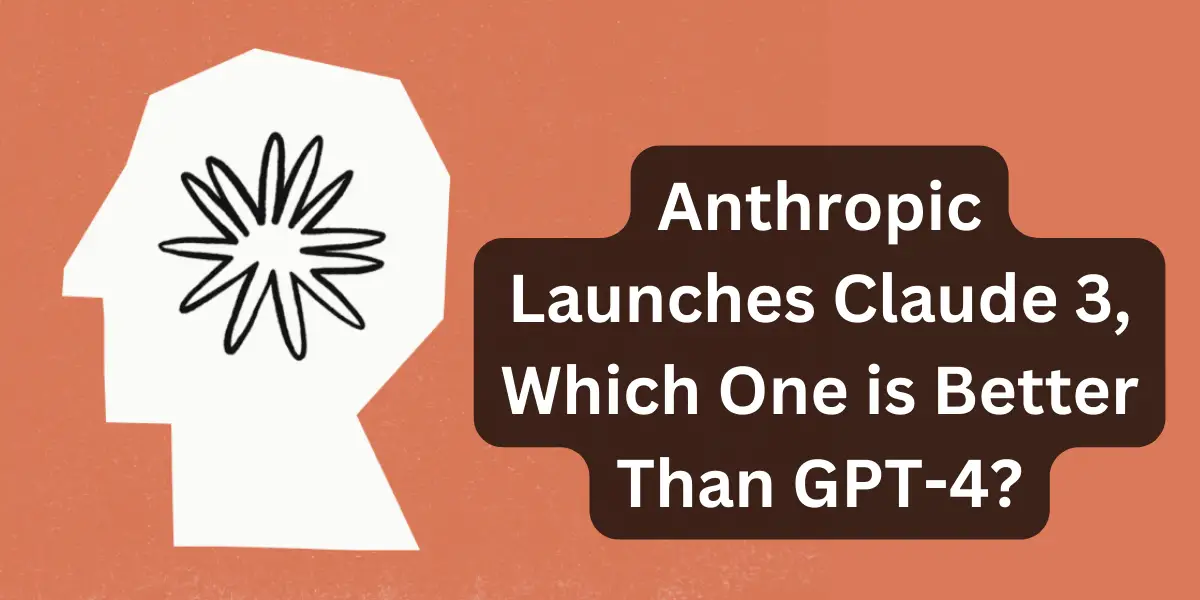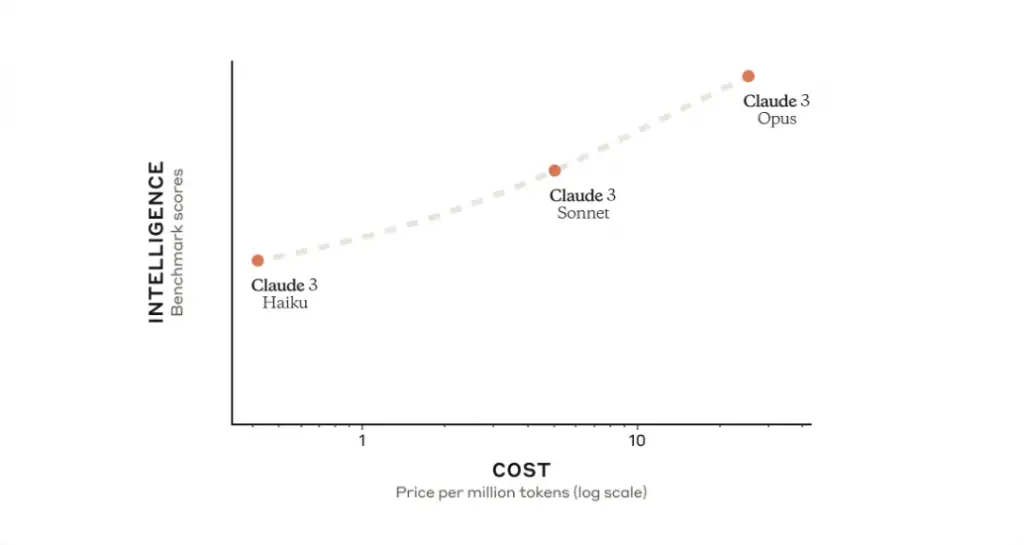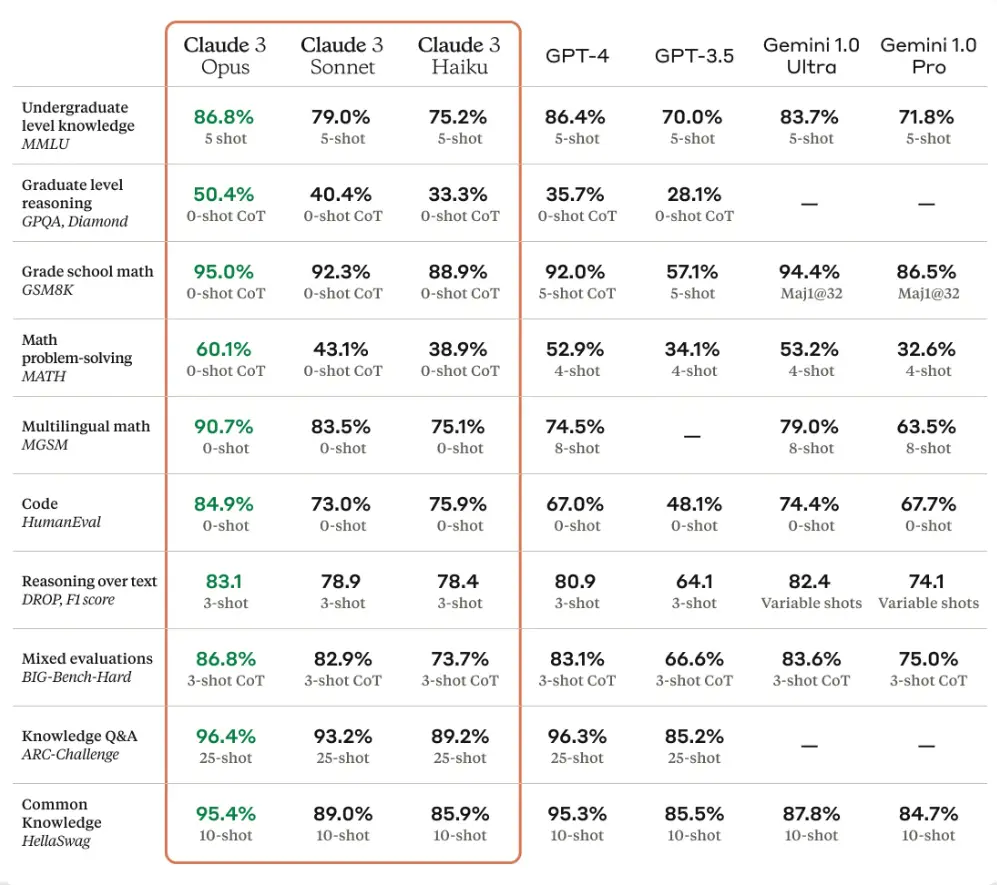Anthropic Launches Claude 3, Better Than GPT-4?

The AI landscape is witnessing a monumental shift with the introduction of Claude 3 by Anthropic, setting new benchmarks in the realm of artificial intelligence. This innovative model is not just a step forward but a leap into the future of AI capabilities, challenging the status quo and raising intriguing questions about the potential of AI technologies.
Table of Contents
What is Claude 3?
Claude 3 represents the pinnacle of Anthropic’s AI development efforts, designed to surpass existing models like GPT-4 in various cognitive tasks. This advanced AI model is part of a family that includes Claude 3 Haiku, Claude 3 Sonnet, and Claude 3 Opus, each offering escalating levels of intelligence and capability. With its unparalleled performance, Claude 3 is poised to redefine expectations in AI, boasting near-human comprehension and fluency in complex tasks, and setting a new standard for general intelligence in AI systems.
Key Features of Claude 3
Claude 3, Anthropic’s latest AI marvel, is redefining the boundaries of artificial intelligence with its groundbreaking features. This advanced model, part of the Claude 3 family including Haiku, Sonnet, and Opus, brings a suite of enhancements that push the envelope of what AI can achieve in various domains.
Enhanced Cognitive Abilities
Claude 3’s cognitive capabilities set it apart from its predecessors, showcasing a remarkable leap in AI’s ability to understand and process complex information. This model demonstrates proficiency in a range of intellectual tasks:
- Deep Understanding: Claude 3 exhibits an in-depth comprehension of subjects, enabling it to provide detailed explanations and insights.
- Advanced Reasoning: The model’s reasoning abilities allow it to tackle complex problems, offering solutions that reflect a higher level of cognitive processing.
- Broad Knowledge Base: With a vast repository of information, Claude 3 can engage in discussions across a wide array of topics, from science to humanities.
These cognitive advancements make Claude 3 an invaluable tool for researchers, educators, and professionals seeking AI assistance in sophisticated tasks.
Multimodal Functionality
The introduction of multimodal capabilities in Claude 3 marks a significant advancement in AI technology. This feature allows the model to process and interpret both text and images, enhancing its applicability:
- Image Analysis: Claude 3 can analyze and comprehend content within images, extending its utility to visual data interpretation.
- Text and Image Synthesis: The model’s ability to integrate text and image data enables it to provide more comprehensive responses and analyses.
- Versatile Applications: This multimodal approach opens up new possibilities for Claude 3’s use in fields such as medical diagnosis, design, and more.
The multimodal functionality of Claude 3 broadens the scope of AI applications, offering users innovative ways to interact with and leverage AI technology.
Improved Interaction Speed
Claude 3’s enhanced interaction speed is a game-changer for real-time AI applications, ensuring users can benefit from AI insights without significant delays:
- Real-Time Responses: The model’s ability to provide near-instantaneous feedback makes it ideal for applications requiring immediate interaction, such as customer support.
- Efficient Data Processing: Claude 3’s quick data processing capabilities enable faster analysis and decision-making in business and research contexts.
- Seamless User Experience: The improved speed contributes to a smoother, more efficient user experience, making AI interactions more natural and productive.
The combination of Claude 3’s enhanced cognitive abilities, multimodal functionality, and improved interaction speed represents a significant leap forward in the evolution of AI. These key features not only enhance the model’s performance but also expand its potential applications, making it a versatile and powerful tool in the advancement of AI technology.

How to Register Access Claude 3?
Gaining access to Claude 3 involves a straightforward process:
- Visit the Official Platform: Start by navigating to the official Anthropic or Claude 3 website or platform offering Claude 3 access.
- Select the Desired Model: Choose from the Claude 3 model family according to your needs, be it Haiku, Sonnet, or Opus.
- Sign Up for Access: Complete the registration process by providing the necessary details and agreeing to any terms of service.
How to Use Claude 3?
Utilizing Claude 3 effectively involves a few key steps:
- Integration: Begin by integrating Claude 3 into your system or application through the provided API or platform-specific instructions.
- Customize Settings: Tailor the Claude 3 settings to suit your specific requirements, adjusting for tasks, speed, and intelligence level.
- Engage with the Model: Start interacting with Claude 3, using its capabilities for tasks such as content creation, data analysis, or customer support.
With these steps, users can harness the full potential of Claude 3, leveraging its advanced AI capabilities to enhance their projects, services, and research endeavors.
Pricing of Claude 3
Anthropic has structured the pricing for Claude 3 to accommodate the diverse needs of its users, ensuring access to its advanced features while maintaining scalability for various applications:
- Claude 3 Haiku: Aimed at more casual or entry-level use, offering basic features at a cost-effective price point.
- Claude 3 Sonnet: Targets professional users requiring a balance between advanced features and cost, ideal for medium-scale applications.
- Claude 3 Opus: Designed for high-end users and enterprises, providing the full suite of Claude 3’s capabilities at a premium price.
This tiered pricing model allows users to select the version of Claude 3 that best fits their needs and budget, making cutting-edge AI technology accessible to a broader audience.
Model | Input Cost ($/million tokens) | Output Cost ($/million tokens) | Context Window | Differentiator |
|---|---|---|---|---|
Claude 3 Opus | $15 | $75 | 200K* | Higher intelligence than any other model available. |
Claude 3 Sonnet | $3 | $15 | 200K | More affordable than other models with similar intelligence; better for scale. |
Claude 3 Haiku | $0.25 | $1.25 | 200K* | Smarter, faster, and more affordable than other models in its intelligence category. |
Claude 3 VS GPT-4

The comparison between Claude 3 and GPT-4 illuminates the advancements and unique features each brings to the AI landscape.
Performance and Accuracy
- Claude 3 boasts improvements in understanding and problem-solving, potentially offering more accurate and contextually relevant responses than GPT-4.
- GPT-4 has set high standards in generative AI, but Claude 3’s advancements might edge out in specific cognitive tasks.
Multimodal Capabilities
- Claude 3 introduces multimodal functionalities, processing both text and images, a feature that sets it apart from the primarily text-based GPT-4.
- This capability expands Claude 3’s applicability in fields such as medical imaging, design, and visual content creation.
Real-Time Interaction
- Claude 3’s focus on enhanced interaction speed aims to provide a more seamless and efficient user experience, potentially surpassing GPT-4 in applications requiring real-time feedback.
- The improved speed could make Claude 3 more suitable for live customer service, interactive applications, and time-sensitive data analysis.
The comparison between Claude 3 and GPT-4 highlights the evolving nature of AI technologies, with each model offering unique strengths. Claude 3’s introduction into the market not only challenges existing AI models but also expands the possibilities for AI applications across various sectors.
Limitations in Claude 3's Image Processing
Recognition and Interpretation
Claude 3’s capacity to recognize intricate details within images and accurately interpret their context remains a challenge. This limitation can affect the model’s utility in fields requiring precise image analysis.
- Struggles with complex image compositions
- Limited by current AI technology in understanding abstract visuals
Handling Low-Quality Inputs
The model’s performance significantly drops when dealing with low-resolution or poorly lit images, impacting its effectiveness in real-world applications where high-quality visuals may not always be available.
- Reduced accuracy with low-quality images
- Difficulty in extracting meaningful data from noisy visuals
Ethical and Privacy Concerns
Anthropic has implemented measures to prevent Claude 3 from recognizing or generating identifiable features in images, aligning with privacy and ethical standards but also limiting its functionality in certain applications.
- Inability to process images with identifiable personal details
- Restricted use in applications requiring facial recognition or personal data analysis
Technical Challenges: Bias and Hallucinations in Claude 3
Despite its innovative features, Claude 3 is not immune to the inherent challenges faced by AI models, including bias and hallucinations, which can affect the reliability and integrity of its outputs.
Inherent Model Biases
Like any AI system, Claude 3 can exhibit biases based on its training data, potentially leading to skewed or unfair outcomes in its responses and analyses.
- Risk of reinforcing existing stereotypes or biases
- Challenges in ensuring fairness and neutrality in outputs
Propensity for Hallucinations
AI hallucinations, where the model generates incorrect or nonsensical information, remain a concern for Claude 3, especially in complex or ambiguous scenarios.
- Occasional generation of inaccurate or irrelevant content
- Difficulty in distinguishing between factual and fabricated information
Conclusion
Claude 3 represents a monumental step forward in the integration of AI into our digital lives, offering unprecedented capabilities in cognitive processing and multimodal interactions. However, its journey is not without hurdles. The limitations in image processing and the ongoing battle against biases and hallucinations underscore the complexities of creating an AI that mirrors human intelligence and perception. As Anthropic continues to refine Claude 3, addressing these challenges will be crucial in harnessing the full potential of AI and pushing the boundaries of what these remarkable models can achieve. The future of AI, epitomized by models like Claude 3, promises a landscape where technology and human ingenuity converge to solve some of the most intricate challenges of our time.

